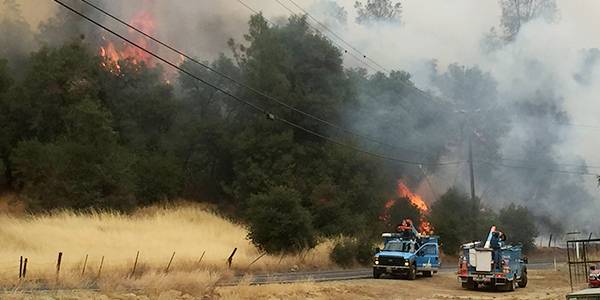By Hudson Sangree

“This is a long-term approach to frankly de-risking our assets in these high fire-prone areas,” CEO Geisha Williams told analysts on the call.
The fire-prevention plans also are part of PG&E’s efforts to reassure nervous financial markets. The company has watched its stock price plummet in the past year as investors worried about its potential multibillion-dollar liability for a series of devastating fires in 2017.
In August 2017, PG&E’s stock hit a high of more than $70/share but had sunk to about $41 by February amid talk of potential bankruptcy. The price had climbed back to nearly $49 as of Tuesday.
On Monday, the company reported Q3 net income of $564 million ($1.09/share), compared with net income of $550 million ($1.07/share) for the third quarter of 2017.
Williams began the earnings call by acknowledging the one-year anniversary of the October 2017 fires that tore through California’s wine country in Napa and Sonoma counties and leveled a portion of the city of Santa Rosa. State fire officials have blamed the company’s equipment for some of those fires, while others are still under investigation.
Some estimates have suggested PG&E’s eventual liability could be up to $15 billion under California’s unique method of holding utilities strictly liable for damage caused by electrical lines and equipment under a legal doctrine called “inverse condemnation.”
That doctrine was the subject of debate this year as the state’s elected officials tried to deal with the threat of PG&E’s financial collapse in the wake of the fires. Gov. Jerry Brown proposed elimination of inverse condemnation as part of SB 901, a landmark wildfire prevention act he signed into law in September. (See Does California need a Catastrophic Fire Fund?)
‘Important Work Remains’
The bill eventually established a procedure by which utilities could issue bonds to pay off wildfire debts, but it did not get rid of inverse condemnation, as Williams noted in the call. She said efforts to reverse the legal doctrine would continue.
“While we believe [SB 901] represents a constructive initial step, more important work remains,” Williams said. “This law provides for improved financial stability for the investor-owned utilities in the state. However, it does not address inverse condemnation, and it remains our firm view that this must be resolved through legislative reforms or legal challenges.”
Meanwhile, PG&E plans to file a wildfire mitigation plan with state regulators in February, as required by SB 901, she said.
Actions already underway include increased vegetation management and daily aerial patrols.
Over the next four years PG&E plans to install 600 high-definition cameras and 1,300 weather stations in fire-prone areas, Williams said on the call. And, she said, “in the next 10 years, we intend to upgrade our system across a targeted roughly 7,000 miles of our highest risk areas with stronger and more weather-resistant poles and insulated tree wire.”
“These plans will be further detailed in the 2020 general rate case that will be filed later this year,” Williams said.
PG&E also is using another, more controversial tactic in its fight against wildfires and wildfire liability.
For the first time, in mid-October, it proactively shut down power lines during what the company said were high-risk weather conditions in the northern San Francisco Bay Area and the Sierra Nevada foothills near Sacramento. (See PG&E Shuts Down Power to Prevent Fires.)
“When the weather improved, our crews conducted patrols across the entire 3,400 impacted miles of our power lines by helicopter, vehicle and on foot, identifying multiple lines that had sustained damage,” Williams said. “Service was restored to nearly all customers within about two days.”
Since then, the company has received numerous complaints from residential customers and businesses that sustained losses, including claims of spoiled food, according to The Sacramento Bee and other news outlets. PG&E filed a compliance report with the California Public Utilities Commission on Oct. 31 defending its decision, the news reports said.
Jamie Court, head of the advocacy group Consumer Watch, has called PG&E’s decision to shut off power to tens of thousands of customers “blackout blackmail.” Immediately after the shutdown in mid-October, he said it was unnecessary and was PG&E’s way of sending a political message. (See Fire Season Becomes Blackout Time in California.)
“They didn’t get inverse condemnation [changed]. They want to get out of liability forever for everything, and this is the way they send a signal,” Court told RTO Insider at the time. “The biggest power a utility has is the ability to turn off power.”
Call transcript courtesy of Seeking Alpha.



